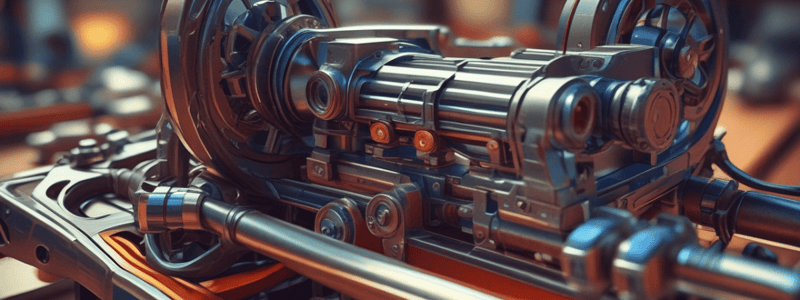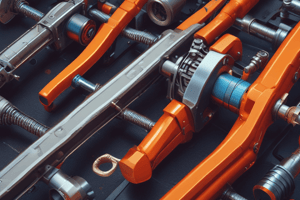Podcast
Questions and Answers
What is the primary function of a linkage?
What is the primary function of a linkage?
- To increase the force applied
- To change the direction of motion
- To reduce the speed of motion
- To transfer energy from an energy source to an object (correct)
Which of the following is a special type of linkage used in large vehicles?
Which of the following is a special type of linkage used in large vehicles?
- Gear train
- Sprocket
- Axle
- Transmission (correct)
What is the primary characteristic of gears when they are meshed together?
What is the primary characteristic of gears when they are meshed together?
- They alternate the direction of spin (correct)
- They increase the force applied
- They change the speed of motion
- They transfer energy from one gear to another
Which of the following statements about gears is true?
Which of the following statements about gears is true?
What is the term used for gears that integrate with a linkage, such as gears on a bicycle?
What is the term used for gears that integrate with a linkage, such as gears on a bicycle?
What is a key feature of a first-class lever?
What is a key feature of a first-class lever?
How does an inclined plane help the user move a larger load?
How does an inclined plane help the user move a larger load?
What distinguishes a wedge from an inclined plane?
What distinguishes a wedge from an inclined plane?
In a second-class lever, where is the load positioned?
In a second-class lever, where is the load positioned?
Which type of lever requires the user to move a greater distance than the load?
Which type of lever requires the user to move a greater distance than the load?
If the number of teeth on the driven gear is 40 and the number of teeth on the driver gear is 20, what is the mechanical advantage?
If the number of teeth on the driven gear is 40 and the number of teeth on the driver gear is 20, what is the mechanical advantage?
If the mechanical advantage of a machine is less than 1, what is true about the input force required?
If the mechanical advantage of a machine is less than 1, what is true about the input force required?
What is the relationship between the mechanical advantage and the distance the input force travels?
What is the relationship between the mechanical advantage and the distance the input force travels?
If a ramp has a greater mechanical advantage, what can be inferred about the ramp?
If a ramp has a greater mechanical advantage, what can be inferred about the ramp?
What is the speed ratio used to measure?
What is the speed ratio used to measure?
What is the purpose of an inclined plane?
What is the purpose of an inclined plane?
What is the relationship between the number of teeth on the driver gear and the driven gear, and the mechanical advantage (MA)?
What is the relationship between the number of teeth on the driver gear and the driven gear, and the mechanical advantage (MA)?
If the speed ratio (SR) of a machine is 0.5, what does this indicate?
If the speed ratio (SR) of a machine is 0.5, what does this indicate?
How does friction affect the mechanical advantage of a machine?
How does friction affect the mechanical advantage of a machine?
What is a way to reduce the effects of friction on mechanical advantage?
What is a way to reduce the effects of friction on mechanical advantage?
What is the mechanical advantage of using a wheelbarrow for Justin to move the load of bricks?
What is the mechanical advantage of using a wheelbarrow for Justin to move the load of bricks?
How is the mechanical advantage of a pulley system calculated?
How is the mechanical advantage of a pulley system calculated?
In the context of calculating mechanical advantage for screws, what does 'l' represent in the formula MA = πdm l?
In the context of calculating mechanical advantage for screws, what does 'l' represent in the formula MA = πdm l?
For a screw with a radius of 9mm and a pitch of 3mm, what is its mechanical advantage?
For a screw with a radius of 9mm and a pitch of 3mm, what is its mechanical advantage?
How does length and height affect the mechanical advantage of an inclined plane?
How does length and height affect the mechanical advantage of an inclined plane?
Study Notes
Mechanical Advantage (MA)
- MA increases when length remains constant and height decreases
- To increase MA, increase length or decrease height
- MA is calculated as output force (load) divided by input force (force you apply) or input arm distance divided by output arm distance
Calculating Mechanical Advantage (Gears/Gear Trains)
- MA is calculated as the gear ratio (GR), where GR is the number of teeth on the driven gear divided by the number of teeth on the driver gear
- Example: MA = 30 teeth / 20 teeth = 1.5
Inclined Planes
- An inclined plane makes it possible to lift heavy objects using a smaller force, but the object must be moved over a longer distance
- MA is calculated as the length of the slope divided by the height of the slope
Speed Ratio (SR)
- SR measures how the speed of an object is affected by a machine
- SR is calculated as the number of teeth on the driven gear divided by the number of teeth on the driver gear
Effects of Friction on MA
- Friction can reduce the efficiency of a machine and decrease MA
- Lubricating machine parts can reduce friction and increase MA
Types of Levers
- First-class lever: fulcrum between the load and the point of effort
- Second-class lever: load is between the effort and the fulcrum
- Third-class lever: effort is between the load and the fulcrum
Inclined Planes and Wedges
- Inclined planes enable users to move larger loads, but require a longer distance to be moved
- Wedges are similar to inclined planes, but are forced into an object and can only be used in one direction
Subsystems that Transfer Forces
- Linkage: a belt or chain to transfer energy from a source to an object
- Transmission: a special type of linkage for transferring energy from the engine to the wheel in large vehicles
Gears
- Four characteristics of gears:
- Gear wheels work together in gear trains
- Gears can change the speed, force, and direction of motion
- Gears will alternate the direction of spin
- Gears integrate with other gears and can integrate with linkages
Studying That Suits You
Use AI to generate personalized quizzes and flashcards to suit your learning preferences.
Related Documents
Description
Learn about levers, a rigid bar that can rotate around a fixed point called a pivot or fulcrum. Discover how different types of levers - first class, second class, and third class - are used to move loads by exerting effort at different points.




